Millstone images 8 - Pulp Stones Home Millstone page
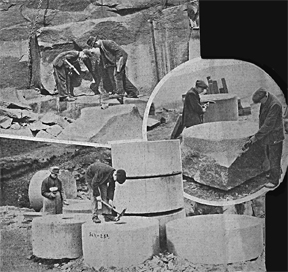 |
A rare, perhaps unique, set of images from 1934: stones for Scandinavian wood pulp mills being quarried and formed near Ashover. Pulp stones were of two types, one smaller than millstones, (as seen at Surprise View - see below) and the other much thicker, weighing 3 tons or more; their size is illustrated at bottom left. Although steam powered machinery to form stones was available by this date, the inset on the right appears to show a massive pulp stone being directly formed by chipping a block away with mauls, an extremely skilled job. The men at top left (the one with a bowler would have been the foreman) appear to be freeing a block by driving wedges; (explosives shatter rock).
|
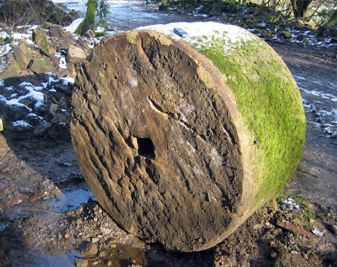 |
A massive pulp stone formed by machine at Stoke Quarry. 20th century stones are typically a metre or more thick and almost 2 metres in diameter. Note the small eye - only required for a spindle, not to feed stock. Lewis Jackson's book "Darleys in the Dale" (Country Books 2006) contains a series of photos, data from the early 20th century, of Stancliffe Quarry in Darley Dale, showing a dozen or more railway trucks loaded with pulp stones similar to this, destined for Scandinavia or North America.
|
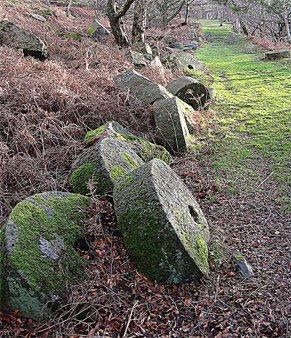 |
A much smaller type of pulp stone just below Surprise View. These are not millstones: the eye is too small, the faces are convex and their diameter is only about a metre. At least 200 can be found, on each side of a track built to serve the quarry (left of the photo) that supplied stone for the Howden and Derwent dams between 1901 and 1916. Some claim they were a shipment destined for Scandinavian pulp mills cancelled by the outbreak of war in 1939. An alternative explanation is that they were quarried as relief for the unemployed in the early 1930's. But see below ...
|
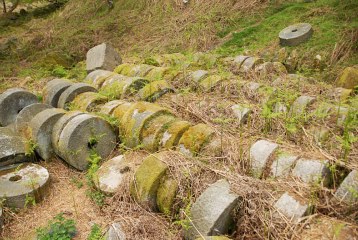 |
This shot shows perhaps a third of the stones below Surprise View. The only historical photos that show ranks of stones like this show pulp stones being shipped from a quarry at Darley Dale for export. It is certainly hard to imagine why stones for milling should have been collected in such numbers.
The stones are so neatly stacked on the uphill side of the track that is is easy to believe that they were placed beside the track ready for transport that never arrived. However, look down the slope and lots of similar stones appear to incorporated in the track, (see below), suggesting they pre-date the quarry. If you know the real history of these stones, let me know!
|
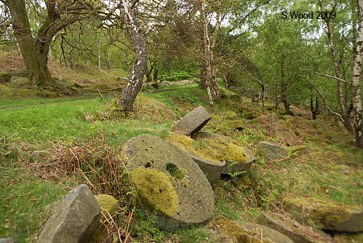 |
50 metres or so north of the shot above - stones very similar to those above seem to be part of the 1901-16 quarry access track. For this reason, my guess is that they date from between the 1860's when large scale newsprint mills were first developed and 1901 when construction of the Howden Dam began.
|
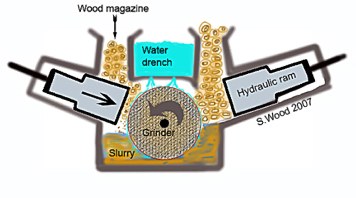 |
Several inventors in Europe and North America developed systems to produce continuous paper sheets from pulped wood in the first half of the 19th century. These were brought together in large paper mills from the 1860's on to produce newsprint & other low quality papers. Short logs were fed into 2 or more magazines after de-barking and hydraulic rams used to force the wood onto a fast moving stone. This causes great friction and heat, so the stone is constantly sprayed with water to control the temperature and wash off the ground wood. A slurry of ground wood fibres collects below the stone: the starting point for wood pulp; this is led off and progressively dried and treated so as to produce paper. Millstone grit stones, mainly, but not only, from Stancliffe (Darley Dale) and Stoke (Grindleford) were used in many mills in North America and Norway well into the 20th century, but were progressively replaced by other systems.
Pairs of stones were used in the late 19th century by "Frambach" grinders to make paper - the URL below gives some detail:
http://www.focol.org/kahs/images/Photos/Frambach_Patent.jpg
and similar stones quarried in British Columbia in the early 20th century. See:
http://www3.telus.net/jenni_gehlbach/quarries.html
|
Copyright @ 2007 Stephen N.Wood. All rights reserved.